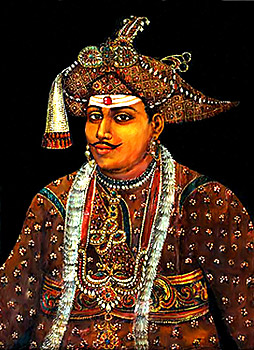 Serfoji II of Thanjavur descended from Shivaji`s half-brother Venkoji. He ruled Thanjavur from 1798 till 1832. He was born on September 24, 1777 in the royal house of the Maratha king, Chattrapathy Shivaji. Raja Thulajah, the king of Thanjavur adopted him as his son on January 23, 1787.
Serfoji II of Thanjavur descended from Shivaji`s half-brother Venkoji. He ruled Thanjavur from 1798 till 1832. He was born on September 24, 1777 in the royal house of the Maratha king, Chattrapathy Shivaji. Raja Thulajah, the king of Thanjavur adopted him as his son on January 23, 1787.
However Thulajah died soon and his half-brother Amar Singh usurped the throne in 1787. He denied the young prince education. Schwartz intervened and sent him to Madras where he was educated by Rev. Wilhelm Gericke of the Lutheran Mission. He knew languages like Tamil, Telugu, Urdu, Sanskrit, French, German, Danish, Greek, Dutch and Latin.
On his behalf the British interposed and Serfoji ascended the throne of Thanjavur on June 29, 1798. Hewas forced to concede the administration of the Kingdom to the British in return, was granted an annual pension of 100,000 star pagodas and one-fifth of the state`s land revenue. His sovereignty was restricted to the Fort of Thanjavur and its surrounding areas. He was the last sovereign ruler of Thanjavur.
Administration under Serfoji II
During his rule for the first time, the proceedings of the Tanjavur court were recorded in paper. The Delta region was divided into five districts, each under a Subedar. Cultivable lands yielded good profits and the judiciary system was efficient. He had built a lot of rest houses for weary pilgrims.
Education under Serfoji II
He founded a school called Navavidhya Kalanidhi Sala where languages, literature, the sciences and arts and crafts were along with the Vedas and shastras. He tried to implement European methods of teachings and education all over his Empire. He supported women emancipation and revolutionized education by appointing women teachers. He installed a hand press with Devanagari type in 1805, the first of its kind in South India. He established a stone type press called "Nava Vidhya Kalanidhi Varnayanthra Sala".
Civic amenities under Serfoji II
He constructed ten water tanks and a number of wells for public use. He implemented an underground drainage system.
He established the Dhanvantari Mahal, a research institution that produced Ayurvedic medicine for humans and animals. It also treated sick people. Physicians of modern medicine, ayurveda, unani and siddha schools have performed research upon drugs and herbs for medical cure.
He created the first Zoological Garden in Tamil Nadu. He erected a shipyard at Manora. He also established a meteorological station to facilitate trade. A gun factory, a naval library and a naval store with all kinds of navigational instruments were also part of his developmental work.
He had great interest in painting, gardening, coin-collecting, martial arts and patronized chariot-racing, hunting and bull-fighting. He was a patron of traditional Indian arts like dance and music. Some of his well known compositions are "Kumarasambhava Champu", "Mudrarakshaschaya" and "Devendra Kuruvanji". He had introduced western musical instruments like clarinet and violin in Carnatic Music.
During his rule the five storeyed Sarjah Mahadi in the Thanjavur palace and the Manora Fort Tower at Saluvanayakanpattinam were constructed. Lightning rods were installed at the top of these monuments. The history of the Bhonsle Dynasty was inscribed on the south-western wall of the Brihadeswarar Temple during his rule which is the lengthiest inscription in the world. Several temples were renovated and constructed during his reign. He was also a philanthropist and a member of the Royal Asiatic Society. He had a secular outlook. He funded churches and schools run by Christian missionaries. He was a patron of Thanjavur Bade Hussein Durgah.
He ruled for almost 40 years. He is considered as one of the greatest kings since Rajaraja Chola I.






































